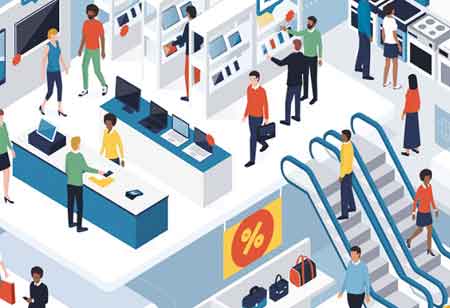Thank you for Subscribing to Construction Business Review Weekly Brief

Technology Trends Transforming the Construction Landscape
Please tell us about your current roles and responsibilities at JLL.
As the President for Americas Project and Development Services, I lead a team of about 9,000 people worldwide in project and development services. We help owners in their design and construction projects, whether they prefer to handle the tasks internally or seek external expertise. I specifically oversee the project management and construction businesses, as well as an in-house design firm, JLL Design Solutions, thatallows us to offer clients a comprehensive range of design and construction services.
What are some of the major challenges in the construction industry space?
The construction industry is poised for growth and success in 2024, thanks to strong demand and the continued normalization of supply chains and material prices.
Still, the construction sector has faced challenges in recent years, primarily due to the pandemic and economic headwinds. In the short term, there may be some fluctuations and occasional pauses in certain projects; however, I anticipate that with the peak of interest rates toward the end of this year and their subsequent decrease in early 2024, construction activities will regain momentum.
We still face a significant shortage of skilled construction labor. Currently, there are approximately 450,000 vacant positions in various trades and general contracting roles, and considering the sector’s growth rate, we estimate we need to fill an additional 600,000 jobs to meet the existing demand.
“Embracing technology and implementing new practices is crucial for the construction industry to break free from traditional methods. Investing in innovative technologies and finding clients open to new approaches are essential steps towards bringing about much-needed change.”
Every day, we witness the persisting challenges in the industry with regards to obtaining difficult-to-acquire materials and goods. This encompasses items such as MEP, infrastructure support, appliances, OSB, and plywood, all of which are in high demand and subject to rising costs.
With inflation starting to decline, we should experience some reliefattributed to the resumption of production for certain items and the resolution of logistical obstacles in sourcing goods from specific countries. Consequently, we can anticipate regaining access to those products.
What are recent trends that have evolved to help tackle these pain points?
The adoption of new and innovative technologiesand methodologies will greatly impact the construction industry and shape its future in various ways. With a shortage of labor, the industry is actively seeking solutions like modular construction. We see this in the rise of industrial work, tilt-up activities, and prefabrication of buildings.The concept of modular construction will constantly progress and expand, particularly in its ability to benefit sectors such as healthcare, hospitality, multifamily, and education.
There is a growing trend in advanced technology, such as 3-D printing, and the design industry is experiencing a surge in the use of artificial intelligence, which lifts our capabilities to another level. Designers not only use AI to create initial designs but also to analyze various alternative scenarios. This enables us to present different components and elements of a floor plan and to assist owners in making diverse choices and evaluating numerous opportunities.
We can use AI for cost takeoffs and predictive analytics to determine material needsto strategically stage the materials at appropriate locations on job sites, ensuring that they are readily available in the areas where construction activities will be taking place.
It can also be as simple as using a phone. Contractors employ mobile applications that allow them to easily locate trades on a job siteto determine if there is available space in another area while they are working in a specific spot.
By implementing methods like installing various cameras or sensors at a work site, we can greatly enhance safety measures. This enables the identification of potential hazards by monitoring the presence of other materials, products, or tasks taking place simultaneously.
We often use a tool called Open Space that uses a camera mounted on a hard hat to capture images as our team or contractors walk through a job site. These images are then stitched together to create a 3-D tour of the space, similar to a video. Additionally, the tool can also identify and read the materials present in the space.
We also use digital twins of buildings to prevent conflicts between materials. For example, if duct work and a sprinkler pipe need to be installed, the digital twins ensure they do not intersect. We have developed a device resembling a Roomba vacuum cleaner.Once programmed, it autonomously moves around and accurately marks the floor to identify the positions of walls, doors, light fixtures, and outlets in each wall.
It’s fascinating to witness the advancements in technology, as they greatly contribute to enhancing the quality of buildings while simultaneously making them more cost-effective and diminishing our reliance on manual labor.
Is there a project initiative that you've been part of recently and have implemented one or couple of these trends to make that successful?
Werecently operateddrone technology to conduct comprehensive surveys of our clients' various facilities. This allowed us to closely examine multiple buildings, thoroughly inspect their roofs and facades, and make informed assessments, allowing our clients to make strategic decisions regarding capital investments in these buildings.
We have been implementing the field layout on numerous projects. One example is Dusty, which is similar to the Roomba. By using Dusty, we have managed to reduce the time required for layout on a tenant space from four or five days to just about a day and a half. This has resulted in significant time savings and has expedited the project effectively.
We consistently use Open Spaces in all our ventures to supervise the construction progress. This enables our clients, who may not be physically present on-site, to conveniently access a video representation of their space's walkthrough whenever they desire.
Any specific piece of advice that you'd like to share with your fellow peers or other industry leaders?
The construction industry has been reluctant to embrace technology and implement new practices, remaining stuck in traditional methods that have been used for decades. It is crucial for us to invest in innovative technologies and, most important, find encourage clients to try out new approaches. To make unique and futuristic buildings a reality, clients need to be open-minded and willing to take risks, which, in turn, drives innovation in the industry. Without their support, progress in building design remains slow and limited to controlled environments.








